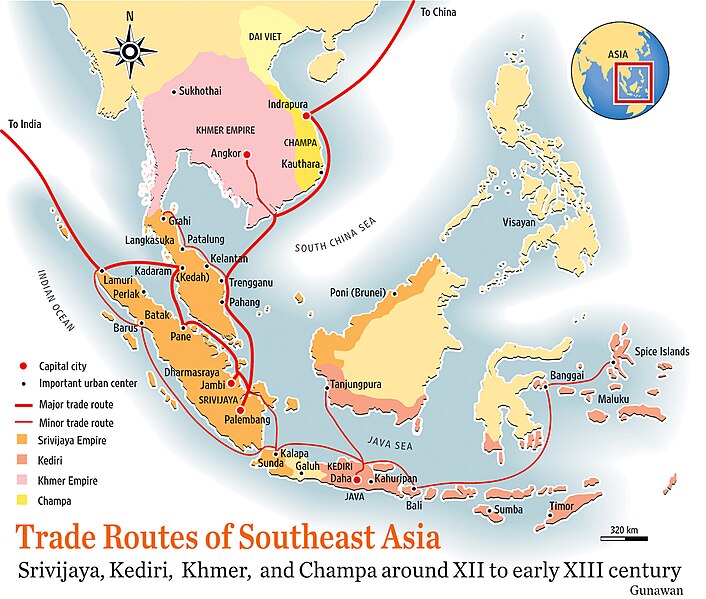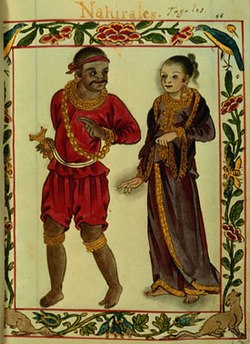Tried searching this here if naa naka post nani. No Results. What do you think about this? So far this confirms the lingering question of the term Visaya/Visayas as it resembles Hindi/Indian so are the titles "DATU and RAJAH" originating from Sanskrit meaning Prince or Ruler.
Who are the Visayans and where do they come from?
Before 500 AD, there are no known archaeological findings of native Southeast Asian Malay inscriptions. Thus, we have to rely on Chinese documents about Southeast Asia. Their records tell of five Southeast Asian states sending trade missions to South China between 430 to 473 AD. After that, the one known by its Chinese toponym Kan-t'o-li prevailed over its neighbors. Historian O.W. Wolters believes that this state was established near Palembang, Sumatra in the second century. Trade stopped during the 500's due to civil strife in China, and Kantoli was never heard of again. Inscriptions in Old Malay appear after 500 AD, notably in Sumatra, Banka Island, Java and the Malay Peninsula. Eight states emerged to resume trade with South China starting 608 AD but by 670 only one remained,Shihli-fo-shih. Artifacts dated 775 AD from the Ligor isthmus of the Malay Peninsula, asexamined by Southeast Asian history pioneer George Coedus, determined that the state known to the Chinese as Shihlifoshih was the same as Sri Vishaya...

Visayan Royal Couple wearing the distinctive color of his class (red).
More illustrations of ancient Filipinos circa 1500's here.
Boxer Codex - Wikipedia, the free encyclopedia
Religion
...Chinese monk I Tsing noted during his travels from 671-695 AD that Sri Vishaya practiced Mahayana Buddhism. If there is a direct link between the Sri Vishaya and the Bisaya of the Philippines, why does the latter show no traces of the Buddhist faith? Only the Vishaya aristocracy adhered to Mahayana. In spite of Mahayana's headstart, it was Hinayana that had greater success in the Southeast Asian mainland. The rest of Vishaya, probably ninety percent, remained animists. This explains the unencumbered spread of Islam later on. The migration of Visayans from the Malay Archipelago to Visayas in the Philippines must have consisted of animists.
Maitreya Buddha or 'Bodhisattva of the future'. Srivijayan art 9th-10th century
Capital
Vishaya established trading outposts in Taiwan. It makes it easy to suppose then that some of them migrated to the Philippines and settled in what is now the Visayas. So where was their first settlement? Probably in Cebu. Possibly not Bohol because some native arts there resemble the Bukidnon's in Mindanao. Negros likewise had sizable remnants of the Bukidnons until recently. Panay has a large population of Karay-as and Aklanons who may antedate the Visayans. Among its neighbors, Cebu seems to have had a Visayan identity for the longest time.

Three major ethnic groups call themselves Bisaya and their language Binisaya. They are the Ilongo, Cebuano and Waray. No matter that they speak three separate languages and have three distinct identities, still they are collectively known as Bisaya. Cebuano may be the purest form of Binisaya. Ilongo root words are mostly Cebuano, with a significant admixture of Tagalog.
Read more here.

Majapahit warriors
Srivijaya Empire was succeeded by another thassalocratic empire the Majapahit 1293-1500. Ang remnants ani nila mao siguro na ang nakit-an sa mga early Spanish explorers. ie Rajahs Humabon and another native leader, Sri Lumay (Rajamuda Lumaya) whose son ruled ancient Singapore or Singhapala also deriving from Sanskrit language.
Results 1 to 10 of 25
-
05-24-2012, 05:53 PM #1Banned User

- Join Date
- May 2012
- Gender

- Posts
- 1,464
 Sri Vishayan Empire "Srivijaya" 650-1290 AD (Hindu Malay-Visayan Empire)
Sri Vishayan Empire "Srivijaya" 650-1290 AD (Hindu Malay-Visayan Empire)
-
05-24-2012, 08:29 PM #2
 Re: Sri Vishayan Empire "Srivijaya" 650-1290 AD (Hindu Malay-Visayan Empire)
Re: Sri Vishayan Empire "Srivijaya" 650-1290 AD (Hindu Malay-Visayan Empire)
burit.. ingun akung papa, gikan kus bukid, silingan sa NPA..
-
05-24-2012, 08:32 PM #3Senior Member

- Join Date
- Jan 2011
- Gender

- Posts
- 569
 Re: Sri Vishayan Empire "Srivijaya" 650-1290 AD (Hindu Malay-Visayan Empire)
Re: Sri Vishayan Empire "Srivijaya" 650-1290 AD (Hindu Malay-Visayan Empire)
a good read!
-
05-24-2012, 08:42 PM #4
 Re: Sri Vishayan Empire "Srivijaya" 650-1290 AD (Hindu Malay-Visayan Empire)
Re: Sri Vishayan Empire "Srivijaya" 650-1290 AD (Hindu Malay-Visayan Empire)
nice one, TS!
dukha is undoubtedly from the sanskrit duhkha. dukha = suffering, poverty / poor, duhkha = suffering. but it's a tagalog term not bisaya.
and the Golden Tara
http://mybutuan.blogspot.com/2007/10/golden-tara.htmlLast edited by Sol_Itaire; 05-24-2012 at 08:47 PM.
-
05-24-2012, 08:47 PM #5
 Re: Sri Vishayan Empire "Srivijaya" 650-1290 AD (Hindu Malay-Visayan Empire)
Re: Sri Vishayan Empire "Srivijaya" 650-1290 AD (Hindu Malay-Visayan Empire)
karon pako ani dah.. hehehe... tinuod ba kaha ni tanan.
-
05-24-2012, 08:52 PM #6
 Re: Sri Vishayan Empire "Srivijaya" 650-1290 AD (Hindu Malay-Visayan Empire)
Re: Sri Vishayan Empire "Srivijaya" 650-1290 AD (Hindu Malay-Visayan Empire)
Good read. I have always wondered about our ancient history. Like what happened pre-spanish era and the likes. Usahay, ma suya ko sa uban civilization kay naa sila history dating back as far as 1000BC..

-
05-24-2012, 09:34 PM #7Banned User

- Join Date
- May 2012
- Gender

- Posts
- 1,464
 Re: Sri Vishayan Empire "Srivijaya" 650-1290 AD (Hindu Malay-Visayan Empire)
Re: Sri Vishayan Empire "Srivijaya" 650-1290 AD (Hindu Malay-Visayan Empire)
Bai salamat. Kalimot ko anang Golden Tara dah, tsk. Pero mao diay dali na imbibe ang Christianity sa rajahnates kay aning panahona Hindu-Buddhist dili man kaayo ni sila strict sa religion unya ang mga nobles ra diay practicing Buddhists, sige pa jud ni sila ug absorb to the point ni fade ang ilang influence and culture. Meanwhile in India ang Moslem invasion that ultimately leads to Malaysia and Indonesia further weakening the Hindu and Buddhist influence. Kani na origin sa Philippine culture makes sense to me.
-
05-25-2012, 08:59 PM #8Banned User

- Join Date
- May 2012
- Gender

- Posts
- 1,464
 Re: Sri Vishayan Empire "Srivijaya" 650-1290 AD (Hindu Malay-Visayan Empire)
Re: Sri Vishayan Empire "Srivijaya" 650-1290 AD (Hindu Malay-Visayan Empire)
Another addition. Maharlika.

Maharlika class nobles from Boxer Codex
Another Hindi word that seems to be very familiar to a lot of Filipinos is Maharlika.
Maharlika refers to a rank of the ancient class system. Members of the Tagalog warrior class resembling a knight in western world and samurai in feudal Japan.
However, according to Indian historian, Prabhat Ranjan Sarkar“They had to arm themselves at their own expense, but they did get to keep the loot they won – or stole, depending on which side of the transaction you want to look at. They were technically less free than the timawas because they could not leave a datu’s service without first hosting a large public feast and paying the datu. Although they were partly related to the nobility, Its origin goes all the way back to the ancient language of India called Sanskrit, from the word, maharddhika, meaning, “a man of wealth, knowledge or ability.” Today it is generally accepted to mean “nobility or aristocracy.”
precolonial name of the Philippines is Maharlika. Maharlika comes from the following Sanskrit derivative: maha, meaning good and great. Mahar is used when referring to something with many good and great qualities, resources, and attributes. Maha became mahar, la means a cup or container, ik means small, and a as a suffix puts it in the feminine gender. So maharlika came from maha + r + ka + ik + a means small entity or country containing good and great qualities and resources in the physical, mental and spiritual sense. And since a beautiful country is referred to as motherland, the suffix A puts it in feminine gender form. – Maharlika.
-
05-30-2012, 06:15 PM #9Banned User

- Join Date
- May 2012
- Gender

- Posts
- 1,464
 Re: Sri Vishayan Empire "Srivijaya" 650-1290 AD (Hindu Malay-Visayan Empire)
Re: Sri Vishayan Empire "Srivijaya" 650-1290 AD (Hindu Malay-Visayan Empire)
'Dug out' one of my Lola's books.
Excerpts from History of the Orient c.1929
A History of the Orient by G. Nye Steiger - Reviews, Discussion, Bookclubs, Lists
Wiley Online Library(.pdf file)
If you're having a problem reading the scans even on enlarge. Try right-clicking it and set to 'View Image'.
-- Each Roman numeral is followed by pictures. If they do not appear refresh the page.
I.

II.

III.

IV.

V.

VI.

VII.

VIII.

IX.

X.

-
05-30-2012, 08:42 PM #10
 Re: Sri Vishayan Empire "Srivijaya" 650-1290 AD (Hindu Malay-Visayan Empire)
Re: Sri Vishayan Empire "Srivijaya" 650-1290 AD (Hindu Malay-Visayan Empire)
Nice find bai...
Advertisement
Similar Threads |
|






 Reply With Quote
Reply With Quote



